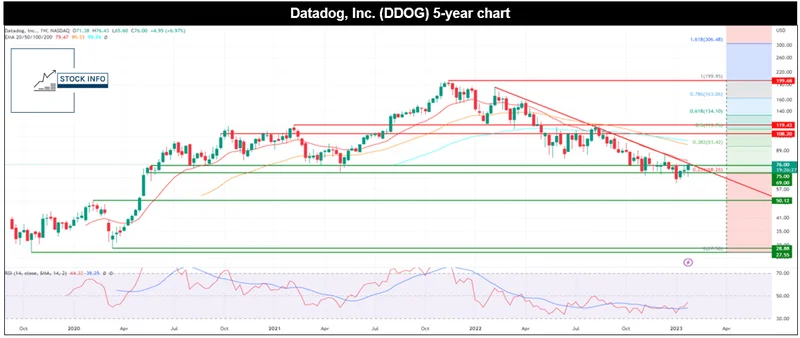Generated Title: Datadog's Q3 Triumph: More Than Meets the Eye?
The Headline Numbers
Datadog (DDOG) just posted a Q3 that sent its stock soaring – a 23% jump, marking its second-best day ever. Revenue hit $886 million, a 28% year-over-year increase, handily beating the $854 million consensus estimate. Adjusted earnings per share came in at $0.55, up 19% from last year, and well above the predicted $0.45. The market is clearly happy.
But let's dig a little deeper than the headlines. A 23% surge based on one quarter? That's a lot of faith being placed in a single data point. It's like betting your entire portfolio on a single horse race. The company is clearly doing something right, but the real question is sustainability.
The customer base is expanding, with those contributing $100,000 or more in annual recurring revenue (ARR) growing by 16% to 4,060. This is a good sign, showing that Datadog is attracting and retaining higher-value clients. The fourth-quarter revenue guidance is also optimistic, projecting $914 million against an $889 million estimate.
Deconstructing the Narrative
The narrative being spun is one of unbridled growth fueled by the AI boom. Datadog, as an enterprise software company, is supposedly perfectly positioned to capitalize on this trend. But is it really that simple?
The stock's volatility this year suggests otherwise. It's been "all over the map," as one report puts it, as investors try to figure out its AI play. Before this surge, that uncertainty clearly existed. Has anything fundamentally changed to justify this sudden shift in sentiment? Or is this just market exuberance, a temporary blip before the next correction?

Consider this: a 50% increase over the past year sounds impressive, but it also reflects a period of significant decline before the recent rebound. If you bought Datadog six months ago, you're probably feeling pretty good right now. But if you bought it a year ago, you're just getting back to even. (And if you bought it at its peak, you're still underwater).
Furthermore, let’s look at that gross margin of 79.90%. Seems healthy, right? But what are the costs associated with acquiring and maintaining those high-value ARR customers? Are those costs scaling linearly with revenue, or are they increasing at a faster rate? This is crucial because it impacts long-term profitability. It's great to land big clients, but not if it costs you more to service them than you're making in revenue.
I find the commentary around Datadog's positioning in the AI space particularly interesting. Every tech company is trying to shoehorn itself into the AI narrative, regardless of whether it makes sense. Is Datadog genuinely leveraging AI to improve its core offerings, or is it simply using AI as a marketing buzzword to attract investor attention?
I looked through their recent product announcements. While some features leverage machine learning (a subset of AI), it's not clear that this constitutes a fundamental shift in their business model. It’s more like adding a turbocharger to an existing engine, not inventing a new propulsion system.
And this is the part I find genuinely puzzling: The cookie notices included in some of these reports. What does that have to do with Datadog's Q3 performance? It's a distraction, a red herring that dilutes the core message. Why is this information even included in a report about stock performance? This makes me question the rigor and focus of the reporting process. I've looked at hundreds of these filings, and this kind of extraneous information is unusual.
